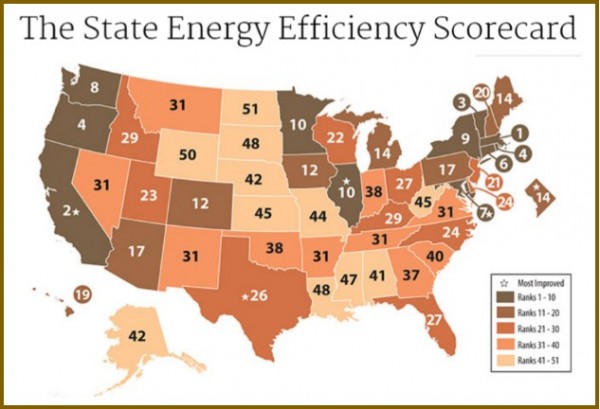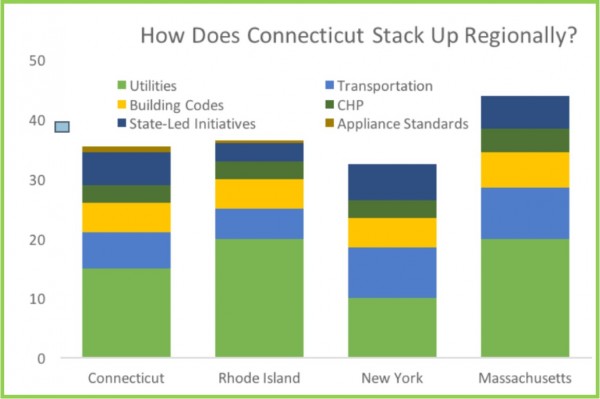CT is a Top-10 State in Energy Efficiency, Recent Growth of Solar Power Capacity
/An annual ranking from the American Council for an Energy-Efficient Economy (ACEEE) rated Connecticut among the top ten energy-efficient states in the country along with Massachusetts, California, Vermont, Rhode Island, Oregon, Maryland, Washington, and New York, with Minnesota and Illinois tied for 10th place.
Connecticut was noted for its financial incentives and energy efficiency investments. The state ranked 6th in the 2015 State Energy Efficiency Scorecard, the same position it held in 2014. The state also earned the same number of points as it did in 2014, totaling 35.5 points out of 50.
According to the report, “Connecticut’s leadership is committed to pursuing policies that encourage energy efficiency within the state, although processes like building code adoption have moved relatively slowly in recent years. Connecticut has put significant resources behind the launching of its green bank. While there are signs of early success, these projects will need to be closely tracked as other states look to Connecticut as an example. Connecticut will need to realize even higher levels of savings in the future in order to remain in the top tier and meet state energy savings targets.”
Connecticut earned 15 out of 20 points for its utility policies and programs, 6 points out of a possible 10 points for transportation policies, 5 points out of 7 for its building energy code stringency a nd compliance efforts, earned 3 points out of 4 for its combined heat and power policies and programs, 5.5 out of 7 points for state-led energy efficiency initiatives, and 1 point out of 2 for appliance standards.
nd compliance efforts, earned 3 points out of 4 for its combined heat and power policies and programs, 5.5 out of 7 points for state-led energy efficiency initiatives, and 1 point out of 2 for appliance standards.
At the bottom of the list were Mississippi, South Dakota, Louisiana, Wyoming and North Dakota.
The ACEEE also developed a similar rating system for the nation’s largest cities, ranking the top 50. Leading the list were Boston, New York City, Washington, San Francisco, Seattle, Chicago, Minneapolis, Portland, Austin and Denver. The only Connecticut city to crack the top 50, Hartford, ranked at number 45. Connecticut’s Capitol City earned 23 points out of a possible 100, in an analysis that included local government operations, community-wide initiatives, building policies, energy & water utilities, and transportation.
The report noted that “policymakers, regulators, and citizens are increasingly recognizing that energy efficiency is a crucially important resource. States and localities are leading the way when it comes to implementing energy-efficient policies and programs.”
The American Council for an Energy-Efficient Economy (ACEEE), a nonprofit, 501(c)(3) organization, acts as a catalyst to advance energy efficiency policies, programs, technologies, investments, and behaviors. The organization believes that “the United States can harness the full potential of energy efficiency to achieve greater economic prosperity, energy security, and environmental protection for all its people.”
Another recent study, “Lighting the Way III: The Top States that Helped Drive America’s Solar Energy Boom in 2014,” by the research and policy arm of Environment Connecticut finds Connecticut ranks 10th nationally for solar power capacity per capita installed in 2014, with 13 watts of solar electric capacity per person installed last year. Nevada led all of the states in 2014, with 119 watts per capita, according to the study. Part of this success is credited to supportive state policymaking. The organization points out that “solar power has tripled in the U.S. in the last two years, with another American family or business going solar every four minutes. That’s in part because the price of solar has dropped more than 50 percent since 2011.”
They add that “research shows the cities and states with the most solar power aren’t necessarily the ones with the most sunshine; they also include states with smart pro-solar policies. States like Connecticut have outpaced sunnier locales like Florida because of policies that allow increasing numbers of homeowners, businesses, communities and utilities to go solar.”
 olar power in Connecticut has grown 221 percent per Capita since 2012, ranking the state 13th in the nation, the report points out. The top solar growth states in the nation, like Connecticut, have adopted renewable energy requirements, strong laws allowing solar customers to sell their excess power to the electric grid, and other policies encouraging growth of the industry, the report indicates. The industry is also adding jobs much faster than the overall economy, employing 1,600 people in Connecticut last year, according to www.solarstates.org
olar power in Connecticut has grown 221 percent per Capita since 2012, ranking the state 13th in the nation, the report points out. The top solar growth states in the nation, like Connecticut, have adopted renewable energy requirements, strong laws allowing solar customers to sell their excess power to the electric grid, and other policies encouraging growth of the industry, the report indicates. The industry is also adding jobs much faster than the overall economy, employing 1,600 people in Connecticut last year, according to www.solarstates.org
“Demand for solar power in Connecticut is growing exponentially,” said Bryan Garcia, President and CEO of the Connecticut Green Bank. “Consumers continue to demand solar power despite a 70 percent reduction in state incentives. In fact, increased private investment has enabled the market to offer lease and loan products that deliver immediate positive cash flow to consumers. This makes solar PV a cleaner, cheaper and more reliable alternative ."
."
Bipartisan legislation signed by Governor Malloy earlier this year lays a foundation for continued growth of solar power, and jobs, in Connecticut, Environment Connecticut points out, citing the stated goal of building enough residential solar systems to power over 40,000 homes in the state by 2022.





























